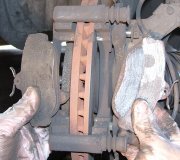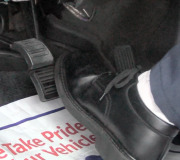DISC BRAKE SHOES
Removal
1. Clean master cylinder reservoir ad filler caps.
2. Remove reservoir filler cap and drain approximately 1/4 of fluid from reservoir. Use clean suction gun or similar device to drain fluid.
3. Raise and support vehicle.
4. Remove front wheel and tire assemblies.
5. Bottom caliper pistons in bores with large C-clamp. Position clamp frame on rear of caliper and clamp screw on outboard brake shoe.
6. With a screw driver pry up on the caliper spring and pull the spring out of the caliper holes
7. Remove caliper slide pins.
8. Remove caliper and brake shoes. See CALIPER.
9. Remove outboard brake shoe. Pry one end of shoe retainer spring away from caliper. See Fig. 25. Then tilt shoe upward and rotate it out of caliper.
10. Remove inboard shoe by tilting shoe outward until retainer spring is clear of caliper piston. See Fig. 26.
CAUTION:DO NOT allow brake hose to support caliper weight.
11. Support caliper with wire from suspension component.
Installation
1. Clean slide surfaces of adapter ledges with a wire brush. The lubricate surfaces with a thin coat of high temperature grease.
2. Install new slide pin bushings if necessary.
3. Install inboard shoe. Be sure retainer spring is firmly seated in caliper piston. See Fig. 26.
4. Insert outboard brake shoe in caliper. Insure outboard shoe retainer spring are seated in the caliper. See Fig. 25.
5. Install caliper and brake shoes over rotor and into adapter.
CAUTION: Start the slide pins by hand before tightening. DO NOT cross
thread the pins.
6. Install and tighten caliper pins.
7. Install caliper spring into one caliper hole and under the adapter. Pull down on the opposite end of the spring and hold the end under the spring. See Fig. 24. With a screwdriver, pry up on the spring to seat the spring into the other caliper hole.
8. Install wheel and tire assembly.
9. Remove support and lower vehicle.
10. Pump brake pedal to seat brake shoes.
11. Fill brake fluid reservoir.
12. Verify a firm brake pedal before moving vehicle.
CALIPER
Removal
1. Clean master reservoir and filler caps.
2. Remove reservoir filler cap. Use clean suction gun or similar device to drain approximately 1/4 of fluid from the reservoir.
3. Raise and support vehicle.
4. Remove front wheel and tire assemblies.
5. Bottom caliper pistons in bores with large C-clamp. Position clamp frame on rear of caliper and clamp screw on outboard brake shoe.
6. Disconnect brake hose at caliper. Discard hose fitting washers if worn, or damaged. See Fig. 23.
7. With a screw pry upon the caliper spring and pull the spring out of the caliper holes.
8. Remove caliper and brake shoes from caliper. See DISC BRAKE SHOES.
Installation
1. Install brake shoes in caliper. See DISC BRAKE SHOES.
2. Install caliper and shoes over rotor and into ledges in steering knuckle. Be sure ends of brake shoes are properly seated on slide surfaces of ledges.
CAUTION: Start the slide pins by hand before tightening. DO NOT cross
thread the pins.
3. Install and tighten caliper slide pins.
4. Install caliper spring into one caliper hole and under the adapter. Pull down on the opposite end of the spring. With a screwdriver pry up on the spring to seat the spring into the other caliper hole. See Fig. 24.
CAUTION:Verify brake hose is not twisted or kinked before tightening
fitting bolt.
5. Install brake hose to caliper with new seal washers and tighten fitting bolt.
6. Bleed brake system.
7. Install wheel and tire assemblies.
8. Remove supports and lower vehicle.
9. Pump brake pedal to seal brake shoes.
10. Fill brake fluid reservoir.
11. Verify firm pedal before moving vehicle.
Images (Click to make bigger)
Monday, February 8th, 2021 AT 5:02 PM
(Merged)















